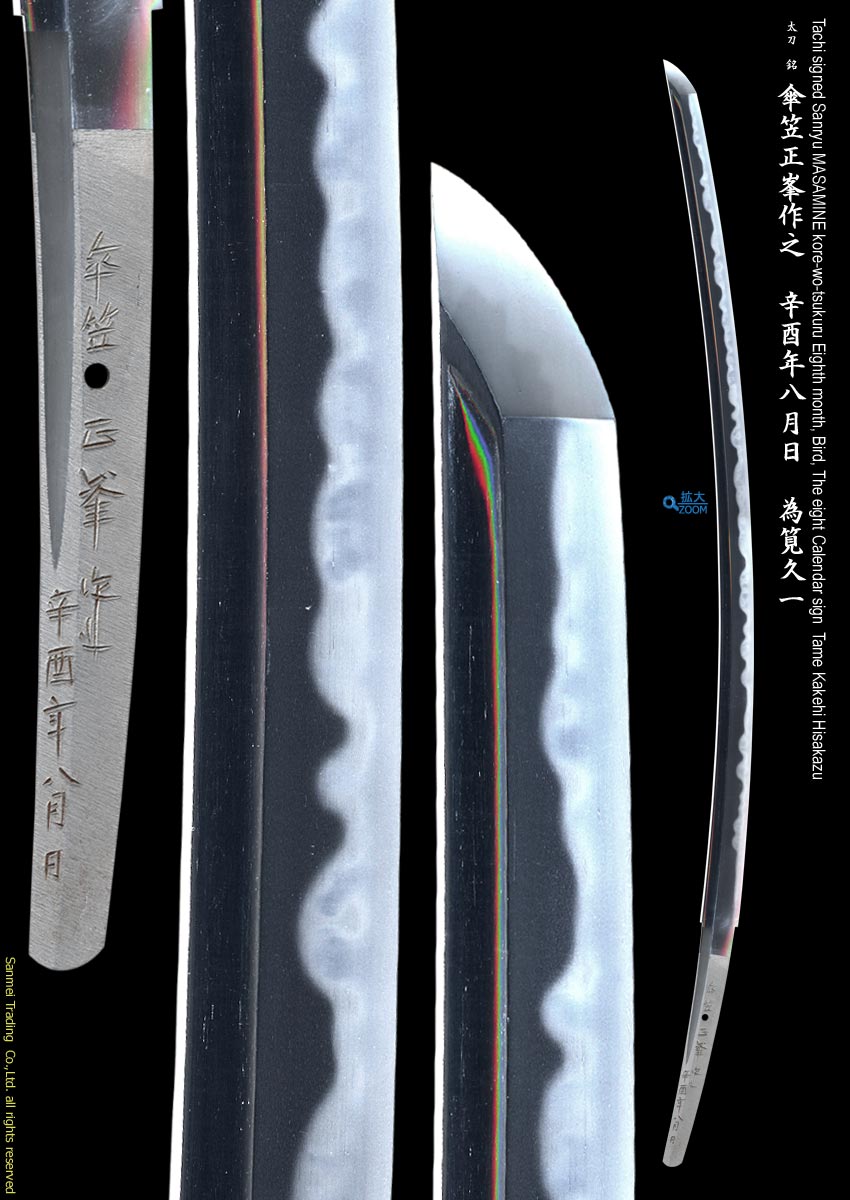Tame Kakehi Hisaichi
Length of cutting edge74.7cm Curvature3.0cm Width of base33.8mm Thickness of base8.0mm Width of Yokote23.9mm
Kitae(forging pattern) : Kitae-hada is ko-itame hada base which is extremely fine and elaborate and covered with blinking Nie hard metal granules over the surface. It's steel shows the mixtures of non-steel elements and uneven status of carbon steel that generates classical grace indication - steel beauty of Kamakura period. Clove heads emit puffing Ji-nie reflections that generates Midare Utsuri reflection throughout Hiraji surface.
Hamon(tempering pattern) : Hamon is fairy Ko-Nie based clove outline (Chojji-midare), mixing in with Fukuro-puff Choji, Tadpole shape Choji midare, varies in height and angle, there works with ASHI feet give off delicately toward the cutting edge. Filled in with whitish NIOI activity in the interior of temper, has close resembles to luxuriant cherry blossoms in full bloom so called [Sumitani Style Choji].
Boshi (tip): The temper of the tip comes irregularly with sharpened up indication then medium circle turns back.
Nakago(tang) : UBU original , Round in full end (Kurikata) heel shape and Osujikai/Kesho (slanting left with horizontal) filemarks. The signature in hakiomote (Tachi style) starts with his atelier name [Sanryu] and his given name [MASAMINE] kore-wo-tsukuru and the date of year [8 th month, Bird, the 8 th calander sign] (A.D.1981) and the ura side is chiselled to order of [Kakehi Hisamichi].
Sumitani Masamine was born as an eldest son of a long-established soy sauce industry in the (1921), Ishikawa Prefecture Matsuto-cho (present and Hakusan City) in 1921. He was admitted to the Ritsumeikan University, Mechanical Engineering Section in Kyoto to realize the dream of the swords production though the expectation that takes over his family's business, and it encounters the establishment of "Ritsumeikan University Japanese sword Studio" that becomes meeting of the fate. He learned from his master [Masayuki Sakurai ] here and his basic artistic view was made out. He moved to "Foundation of National Japanese Sword Studio" in Hiroshima Prefecture Onomichi City with the senior pupil after the accident burnt down of Ritsumeikan University Japanese sword studio. However, after the end of World War II, even in the depths of despair, he clung to a thread of hope to be a sword smith, while helping his family business, he still met a chance to offer a sword to the Grand Shrines of Ise
(59 th move ceremony of Shrine). After this occasion, smith Masamine had come to be absorbed in the research to the old celebrated sword. He himself collected Iron Sand from Mountain/Rivers and established Tatara style steel refine smelting furnace.He created and reproduced a finest steel texture beauty using pig iron, not comes only from pure Tamahagane steel.
He nominated and specified for the living national treasure in 1981 by distinguished services that inquired into beauty as not only a recreation of famous Osafune initial work or of Ichimonji works but also generation of the finest Japanese steel. This tachi is a work of maturity when he was 61 years old - the year he became an intangible cultural asset holder (Japanese sword). When his atelier was built to home in 1956, he named it as [Sanryu] which was succeeded and assumed to the title in the buildings that existed in Kyoto Ritsumeikan University. He recovered from the severe wound of the defeat, and surely this is the masterpiece of Sumitani Masamine that inquires into the beauty of harmony.
Gold double rayer habaki collar, Shira-saya plain wood mouting
